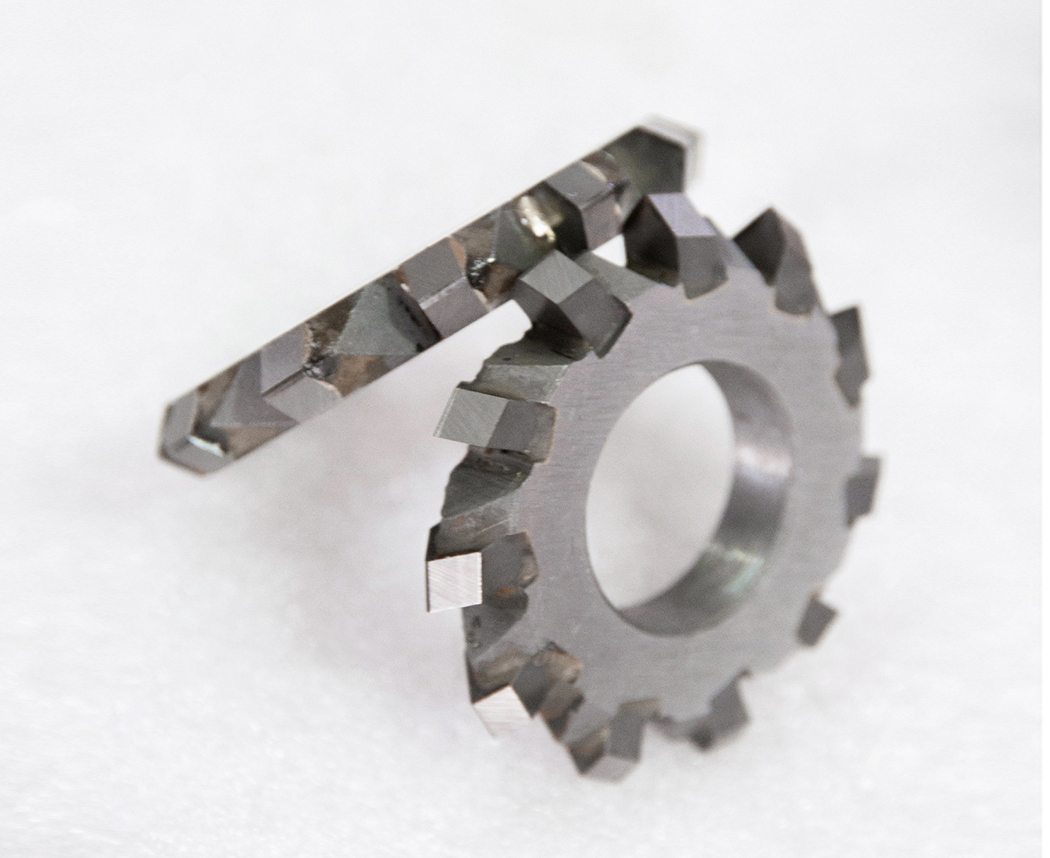News Center
Recommending Products
Contact: Mr. Jin
Tel: 13901575780
0512-52428686
Contact: Mr. Zha
Tel: 13913639797
0512-52422071
Address: No. 59, Huyi Road, Liantang, Shanghu Town, Changshu City, Jiangsu Province.
What are the characteristics of coated saw blade milling cutters
Sources:m.itartisan.cn | PublishDate:2024.11.06
Coated saw blade milling cutters have the following characteristics:
1、 Superior cutting performance
1. High hardness and wear resistance
The coating can significantly improve the surface hardness of the saw blade milling cutter, making it more wear-resistant during the cutting process. For example, by using advanced coating technology such as TiAlN (titanium aluminum nitride) coating, the hardness can reach an extremely high level, which can effectively resist wear during cutting and greatly extend the service life of the tool.
Even in high-speed cutting and processing of hard materials, coated saw blade milling cutters can maintain good cutting performance, reduce tool wear and replacement frequency, and lower production costs.
2. Good thermal stability
The coating has good thermal stability and can withstand high temperatures generated during the cutting process. During high-speed cutting, cutting heat can cause a sharp increase in tool temperature, while coatings can effectively insulate and reduce heat transfer to the tool substrate, preventing the tool from losing hardness and strength due to overheating.
For example, when processing difficult to machine materials such as high-temperature alloys, coated saw blade milling cutters can maintain stable cutting performance without problems such as chipping or deformation due to high temperatures.
3. Low friction coefficient
The coating surface usually has a lower coefficient of friction, which helps reduce the generation of cutting forces and cutting heat. During the cutting process, a low friction coefficient can reduce the friction between the tool and the workpiece, lower the cutting force, and thus reduce power consumption and tool wear.
At the same time, a low friction coefficient can also improve the surface quality of the processed workpiece, reduce surface roughness, and make the processed workpiece surface smoother.
2、 High processing quality
1.Accurate size control
The manufacturing accuracy of coated saw blade milling cutters is high, which can ensure the accuracy of machining dimensions. The diameter, thickness, tooth profile and other parameters of the cutting tool are strictly controlled to ensure accurate cutting of the required dimensions during the machining process.
For example, in precision machining, coated saw blade milling cutters can produce high-precision planes, grooves, and contours that meet strict dimensional tolerance requirements.
2.Good surface quality
Due to the characteristics of the coating, saw blade milling cutters can achieve good surface quality during the cutting process. Coatings can reduce friction between cutting tools and workpieces, lower cutting forces, and thus reduce surface roughness and residual stresses during machining.
At the same time, the coating can also prevent chips from adhering to the tool, avoiding scratches and damage to the machined surface. For example, when processing non-ferrous metal materials such as aluminum alloys and copper alloys, coated saw blade milling cutters can produce bright and smooth surfaces.
3、 Wide applicability
1.Can process multiple materials
Coated saw blade milling cutters are suitable for processing various materials, including metallic materials such as steel, cast iron, aluminum alloys, copper alloys, as well as non-metallic materials such as plastics, wood, composite materials, etc. Different coating materials can be optimized for different materials to improve the cutting performance and service life of cutting tools.
For example, for metal materials with high hardness, coatings with high hardness and good wear resistance can be selected; For materials with high viscosity, coatings with good anti adhesion properties can be selected.
2.Adapt to different processing conditions
Coated saw blade milling cutters can adapt to different machining conditions, such as high-speed cutting, dry cutting, wet cutting, etc. Under different processing conditions, coatings can play different roles in improving tool performance and processing efficiency.
For example, in high-speed cutting, coatings can improve the thermal stability and wear resistance of cutting tools; During dry cutting, coatings can reduce friction between the tool and the workpiece, and decrease the generation of cutting heat; During wet cutting, coatings can prevent tool rust and corrosion.
1、 Superior cutting performance
1. High hardness and wear resistance
The coating can significantly improve the surface hardness of the saw blade milling cutter, making it more wear-resistant during the cutting process. For example, by using advanced coating technology such as TiAlN (titanium aluminum nitride) coating, the hardness can reach an extremely high level, which can effectively resist wear during cutting and greatly extend the service life of the tool.
Even in high-speed cutting and processing of hard materials, coated saw blade milling cutters can maintain good cutting performance, reduce tool wear and replacement frequency, and lower production costs.
2. Good thermal stability
The coating has good thermal stability and can withstand high temperatures generated during the cutting process. During high-speed cutting, cutting heat can cause a sharp increase in tool temperature, while coatings can effectively insulate and reduce heat transfer to the tool substrate, preventing the tool from losing hardness and strength due to overheating.
For example, when processing difficult to machine materials such as high-temperature alloys, coated saw blade milling cutters can maintain stable cutting performance without problems such as chipping or deformation due to high temperatures.
3. Low friction coefficient
The coating surface usually has a lower coefficient of friction, which helps reduce the generation of cutting forces and cutting heat. During the cutting process, a low friction coefficient can reduce the friction between the tool and the workpiece, lower the cutting force, and thus reduce power consumption and tool wear.
At the same time, a low friction coefficient can also improve the surface quality of the processed workpiece, reduce surface roughness, and make the processed workpiece surface smoother.
2、 High processing quality
1.Accurate size control
The manufacturing accuracy of coated saw blade milling cutters is high, which can ensure the accuracy of machining dimensions. The diameter, thickness, tooth profile and other parameters of the cutting tool are strictly controlled to ensure accurate cutting of the required dimensions during the machining process.
For example, in precision machining, coated saw blade milling cutters can produce high-precision planes, grooves, and contours that meet strict dimensional tolerance requirements.
2.Good surface quality
Due to the characteristics of the coating, saw blade milling cutters can achieve good surface quality during the cutting process. Coatings can reduce friction between cutting tools and workpieces, lower cutting forces, and thus reduce surface roughness and residual stresses during machining.
At the same time, the coating can also prevent chips from adhering to the tool, avoiding scratches and damage to the machined surface. For example, when processing non-ferrous metal materials such as aluminum alloys and copper alloys, coated saw blade milling cutters can produce bright and smooth surfaces.
3、 Wide applicability
1.Can process multiple materials
Coated saw blade milling cutters are suitable for processing various materials, including metallic materials such as steel, cast iron, aluminum alloys, copper alloys, as well as non-metallic materials such as plastics, wood, composite materials, etc. Different coating materials can be optimized for different materials to improve the cutting performance and service life of cutting tools.
For example, for metal materials with high hardness, coatings with high hardness and good wear resistance can be selected; For materials with high viscosity, coatings with good anti adhesion properties can be selected.
2.Adapt to different processing conditions
Coated saw blade milling cutters can adapt to different machining conditions, such as high-speed cutting, dry cutting, wet cutting, etc. Under different processing conditions, coatings can play different roles in improving tool performance and processing efficiency.
For example, in high-speed cutting, coatings can improve the thermal stability and wear resistance of cutting tools; During dry cutting, coatings can reduce friction between the tool and the workpiece, and decrease the generation of cutting heat; During wet cutting, coatings can prevent tool rust and corrosion.






